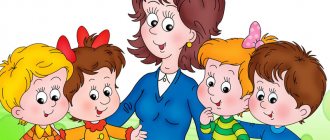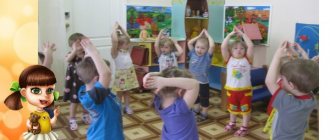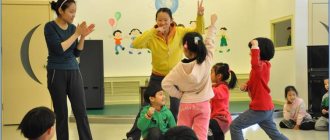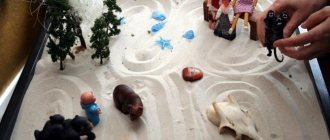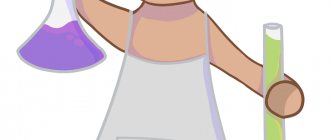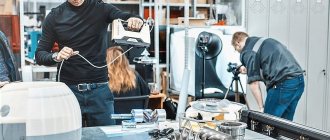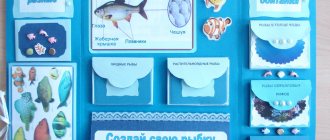Innovative technology in preschool education “Club Hour”
Innovative technologies in preschool institutions play a huge role in the development of children. And the more interesting the technology, the more effective the result. In my article I want to talk about the effectiveness of such innovative technology as “Club Hour”, and about experimental activities that were tested in our preschool institution. For this activity, I wrote a project that was implemented both during Club Hour and in my free time.
Childhood is a promise that never comes true.
Ken Hill
“There are now many problems with the intellectual development of modern preschool children. But the development of children begins in childhood. What do we know about childhood? “Due to the widespread prevalence of this concept, each of us is sure that we know everything about childhood and can easily explain this phenomenon and its significance in the life of an adult. But it is precisely this simple understanding of childhood from a philistine point of view that hides the unidentifiability and inexplicability of this phenomenon. As J. Korczak rightly writes: “We don’t know children, worse, we know them through prejudice.” [1, p.16]
Therefore, in preschool organizations, teachers began to use various modern innovative technologies to ensure that the level of children’s preparation for school was high. The leading activity in preschool educational institutions is play. “A game is an activity used for entertainment, recreation, or sports competition.” [2]. One of the gaming technologies is Club Hour.
“Club hour” is a pedagogical technology aimed at developing self-regulation (voluntariness) of behavior, the ability to plan activities, and evaluate results. It is impossible to implement pedagogical technology without a clear definition of tasks.
One of the main tasks of education that any teacher sets for himself is the socialization of students. It is in kindergarten that children learn to make friends, play, communicate, and begin to feel like members of a large children's team. The foundations of patriotic feelings are formed in children.
“Club hour, a technology that allows children, under the invisible control of adults, to move freely around the territory of a kindergarten or school and in different rooms to choose the activities that they like. Acquire your own life experience and experiences, which are so necessary for self-determination and self-regulation of behavior.” .
Through the Club Hour there is live communication with other teachers and children.
The main goals of the CC:
– instilling in children independence and responsibility for their actions;
– developing the ability to plan your actions and evaluate their results;
– acquisition of one’s own life experience (semantic formations) experiences necessary for self-determination and self-regulation.
– training in spatial orientation;
– nurturing friendly relations between children of different ages, respectful attitude towards others;
– development of children’s desires to express their attitude towards the environment, to independently find various speech means for this;
– strengthening children’s skills to politely express their request and thank them for the service provided;
– teaching children how to resolve controversial issues and resolve conflicts;
– promoting the manifestation of initiative in caring for others, being grateful to help and signs of attention;
– encouraging the child’s attempts to consciously share various impressions with the teacher and other children.
According to Grishaeva, Club hours are divided into types:
- Activity - this type is based on the child’s self-determination in choosing various types of activities;
- Thematic - in this case, “Club hours are included in the situation of the month”;
- Free - children move freely around the territory of the kindergarten and independently organize communication of different ages based on interests without the help of adults;
- Creative - children of the preparatory group themselves organize all the activities at the “Club Hour” for all children;
- Group formation - children spend “Club Hour”, uniting in groups and teams to develop group skills;
- Quest - children on the territory of a site or premises, alone or in a team, look for some thing or object according to a scheme, solve some problem;
- Museum - children in the “situation of the month” collect exhibits, and then at the end of the month, independently conduct excursions for other children who came. [3]
I developed the project “Experiments - Focuses - Experiments”. It was included in the general innovation project of our preschool institution “Cognition through experience, experience through cognition.” The goal of the overall project was to create conditions to support exploratory behavior in preschoolers in kindergarten. This project included four subprojects: “Laboratory”, “Magic Sand”, “The Charming World of the Microscope” and my “Experiments - Tricks - Experiments”.
The goal of my project was to create conditions for experimental activities of children in kindergarten, the formation of an environmental culture, and the development of cognitive interest. Having worked for many years in a preschool institution, I have observed many times how children like something unusual and wonderful. Therefore, the relevance of my project was indicated by the fact that research provides an opportunity for a child to answer the questions “how?” and why?". An unquenchable thirst for new experiences, curiosity, a constant desire to experiment, and independently seek new information about the world are considered the most important features of children's behavior. Research activity is the natural state of a child; he is determined to understand the world, he wants to know everything and be able to do everything himself. This is a huge opportunity for children to think, reflect, try, experiment, and express themselves. The experiments somewhat remind children of magic tricks, they are unusual, they surprise. The child’s need for new impressions underlies the emergence and development of inexhaustible orientation-research (search) activity aimed at understanding the world around him. The more varied and intense the search activity, the more new information the child receives, the faster and more fully he develops.
My project objectives:
– create conditions for the formation of cognitive interest in children.
– develop children’s curiosity in the process of observation and practical experimentation with objects.
– to form skills of mental actions, analysis in the process of cognition of the natural picture of the world, contributing to the development of speech.
– develop independence in resolving problem situations in research activities.
– learn to explain what is observed.
The topics planned for the Club Hour were also planned for my project. The children and I mixed paints, got new colors, studied the properties of water, magnets, iron, and fabric. We conducted experiments with light and a mirror. A card index of experiments was developed, with explanations. Tables for conducting experiments were developed and drawn. At the Club Hour, children watched an experiment conducted by a teacher. Then there was a discussion, and at the end the children could independently conduct the experiment and draw it themselves. I and the parents were given advice on “Organizing children’s experimentation at home.” In a preschool educational institution, on experimental activities, I conducted a master class for teachers “Experiments with children.” The purpose of the master class was to improve the professional skills of participating teachers in the process of active pedagogical communication on the problem of children's experimentation.
As a result, at the end of the school year, the children could independently, based on the diagrams, conduct experiments and explain them.
Literature:
- Gogoberidze, A. G. Preschool pedagogy with the basics of methods of education and training / A. G. Gogoberidze, O. V. Solntseva. — 2nd edition, revised and expanded. - St. Petersburg: Peter, 2015. - 460 p. — Text: direct.
- Ozhegov, S. I. Ozhegov’s Explanatory Dictionary - online / S. I. Ozhegov. — Text: electronic //: [website]. — URL: (access date: 01/24/2021).
- Shchetinina, M. V. “Club Hour” technology as a form of support for children’s initiative” / M. V. Shchetinina. — Text: electronic // Doshkolenok.rf: [website]. — URL: https://doshkolnik.ru/pedagogika/27367-tehnologiya-klubnyiy-chas-kak-forma-podderzhki-detskoiy-iniciativy.html (access date: 01/24/2021).
The advantages of this technology are that it does not require any special training for educators, equipment or investment of funds. The main thing is the great desire of the teaching staff to lay the foundations of a full-fledged socially successful personality during preschool childhood.
Goals of the Club Hour:
- instill independence and responsibility in children;
- teach children to navigate in space;
- cultivate friendly relations between children of different ages, respectful attitude towards others;
- develop the ability to take initiative in caring for others, to be grateful for help and signs of attention;
- develop the ability to plan your actions and evaluate their results;
- teach children to politely express their request and thank them for the service provided;
- develop the desire to express one’s attitude towards the environment, independently find various speech means for this;
- develop the ability to resolve controversial issues and resolve conflicts;
- encourage the child’s attempts to consciously share various experiences with the teacher and other children;
- help to acquire life experience (meaning formations), experiences necessary for self-determination and self-regulation.
“Club hour” can be carried out in various forms: as an educational activity in the morning, as an activity in interest groups in the evening, as a form of organizing a walk or leisure activity.
Types of Club Hour:
- “Free” club hour, when children move freely throughout the kindergarten (indoors or outdoors) and independently organize communication of different ages based on interests.
- "Themed" club hour, which is included in the situation of the month. For example, in the “Space” situation, this is a drawing competition on asphalt on space themes, building a spaceship, and “cosmonaut” quizzes.
- “Activity” club hour, when it is based on the child’s self-determination in choosing various types of activities, i.e. for example, in the gym there are outdoor games, in the music hall there is a performance, in one group they bake pies, in another they sew dresses for dolls, etc.
Rules of conduct for children during Club Hour:
- Say “hello” and “goodbye” when you enter another group.
- If you took a toy to play, put it back when you leave.
- Don't take toys from other children if they took it first.
- Help conduct a lesson if it is suitable during the CC
- Speak calmly.
- Walk calmly.
- Return to the group when the bell rings.
- If you don’t want to go to other groups, you can stay in your group or return to it if you’re tired.
Immediately before the first club hour, children discuss all the rules; they are briefly repeated before each club hour. Then instructions are given: “Children, you can move around the entire building for one hour, observing the rules of behavior. And at the ringing of the bell you return to the group.”
After the end of the club hour, all children participants, each in their own group, with a teacher, sit in a circle on the carpet. A candle is lit and meditative music is turned on. The discussion begins. The teacher makes sure that the children do not interrupt each other and speak in turns, patiently waiting until their turn comes.
Description of the “Club Hour” technology: Grishaeva N. P. Modern technologies for effective socialization of a child in a preschool educational organization. – M.: Ventana – Graf, 2015. Buy.
Pedagogical technology club section article (preparatory group) on the topic
PEDAGOGICAL TECHNOLOGY “CLUB HOUR”
S.N. Vorontsova, teacher
“Club hour” is a special modern technology for developing a child’s personality. The experience of using the “Club Hour” was presented by N.P. Grishaeva. Art. research fellow at the Institute of Sciences of the Russian Academy of Sciences and Strukova L.M. teacher-psychologist GBOU 2620. The authors note that modern children live and develop in completely new socio-cultural conditions. Extremely busy parents, a generation gap, marketization and technologization of children's subculture, isolation of the child in the family and other trends negatively affect the socialization of modern children. In kindergartens, a clear preference is given to the cognitive development of a preschooler to the detriment of social and personal development. This is due, on the one hand, to the increase in school requirements for the intellectual level of first-graders, and on the other, to the insufficient development of methods for the social and personal development of a preschool child and the lack of organization of the pedagogical process. It is known that it is in the senior preschool age that the prerequisites for the formation of personality are laid. The development of self-regulation (voluntariness) of behavior begins.
The development of self-regulation is one of the central lines of development for children of senior preschool age. In various types of activities, the most important personal new formation of preschool age is formed - voluntary regulation of behavior and activity, the ability to self-control. Thus, the main goals of the “Club Hour” are:
- instilling in children independence and responsibility for their actions;
- spatial orientation training;
- nurturing friendly relations between children of different ages, respectful attitude towards others;
- promote the manifestation of initiative in caring for others, be grateful for help and signs of attention;
- developing the ability to plan your actions and evaluate their results;
- strengthening children’s skills to politely express their request and thank them for the service provided;
- the development of children’s desires to express their attitude towards the environment, to independently find various speech means for this;
- teaching children how to resolve controversial issues and resolve conflicts;
- encouraging the child’s attempts to consciously share various impressions with the teacher and other children;
- acquiring one's own life experience (meaning formations) experiences necessary for self-determination and self-regulation.
To implement this technology pedagogy, preparatory work is necessary, primarily among parents and teachers. Parents, at the meeting, are warned in advance that this event will be held at the preschool educational institution (day of the week, hour of the event). They are informed about how this will affect children and how their safety will be ensured. Parents are given the opportunity to conduct “master classes” themselves during the C.H. , as well as offer a new theme for club hours.
It is possible to distinguish the following types of “Club Hour”:
- “Free” K.Ch., when children move freely throughout the entire territory of the kindergarten (indoors or outdoors) and independently organize communication of different ages based on interests;
- “Thematic” K.Ch., which are included in the situation of the month. For example, in the “Space” situation, this is a drawing competition on asphalt on space themes, building a spaceship, “astronaut” quiz;
- “Active” K.Ch., when the basis of K.Ch. The child's self-determination is based on the choice of various types of activities, i.e. for example, in the gym there are outdoor games, in the music hall there is a performance, in one group they bake pies, in another they sew dresses for dolls, etc.
Educators and specialists preliminarily discuss and determine:
1. The theme of “Club Hours”, a promising thematic plan by K.Ch. for half a year.
2. Determine the frequency and duration of the training session, usually once a week at the beginning of the program and 2-3 times a week thereafter. One of the main conditions for conducting K.Ch. is its duration, namely at least 1 hour, because otherwise, children do not have time to develop their own life experience.
3. Determine the rules of behavior for children during “Club Hour”
4. Organizational aspects of conducting the competition are being developed.
5. Determine the order in which the K.Ch. program begins. How many groups will participate in the first K.Ch., which groups exactly, how to prepare children for the first K.Ch.
After completing the K.Ch., all children participating, each in their own group, with a teacher, sit in a circle on the carpet. Meditative music is turned on. The discussion begins. The teacher makes sure that the children do not interrupt each other and speak in turns, patiently waiting until their turn comes.
The teacher records the problems that arise in children in the process of K.Ch. and discusses them with children and parents (at a suitable time), finding ways to solve them in joint activities.
After each K.Ch. At the pedagogical council, educators, teachers and staff exchange opinions, achievements, discuss difficulties that have arisen and ways to solve them.
Literature:
Grishaeva N.P., Strukova L.M. Pedagogical technology “Club Hour” as a means of developing self-regulation of behavior of preschoolers in the educational complex // https://profpsy.ru/user-articles.html?view=article&id=217
Experience in the technology of effective socialization N.P. Grishaeva
Experience in using N.P. technology Grishaeva.
Modern society has a need for an independent active personality with pronounced individual qualities, capable of solving and overcoming both personal problems and problems of society. The success of human life in an intensively changing world depends on the ability to find original, unexpected solutions in accordance with the situation.
Socialization, according to the psychological dictionary of B. Meshcheryakov and V. Zinchenko, is the process of assimilation by an individual of social experience, a system of social connections and relationships. In the process of socialization, a person acquires beliefs, socially approved forms of behavior necessary for him to live a normal life in society, and also receives further development of social and personal qualities.
One of the fundamental principles of updating the content of modern education is a student-centered approach. Highlighting the goal of personal development is reflected in government documents. The national project “Education” sets the goal of “raising a harmoniously developed and socially responsible personality based on the spiritual and moral values of the peoples of the Russian Federation, historical and national cultural traditions.” The Law of the Russian Federation “On Education” defines the essence of education in “personal development and the acquisition in the process of mastering basic general education programs of knowledge, abilities, skills and the formation of competence necessary for human life in society.” The introduction of the Federal State Educational Standard for Preschool Education makes it possible to solve the problems of reorganizing a preschool educational organization to create conditions for the development of a child, opening up opportunities for his positive socialization and the development of initiative.
Technologization of the process guarantees a high-quality result of pedagogical activity, paying special attention to the mechanisms of becoming a socially successful personality. New technologies for the socialization of a preschooler make it possible to effectively form and develop self-regulation of behavior, independence, initiative, responsibility - qualities necessary not only for successful adaptation and learning at school, but also for life in modern society.
One of the effective technologies aimed at socializing a preschooler, in our opinion, is the N.P. system. Grishaeva.
Children develop best when they are the agents of their own learning. The process of social and personal development includes various types of activities, which are based on the child’s self-determination in their choice. Revealing the content of the pedagogical technology “Club Hour” N.P. Grishaeva gives the following methodological recommendations: “Children can move around the entire building (or area) of the kindergarten for one hour, observing certain rules of behavior, and return to the group when the bell rings.”
The holding of the “Club Hour” is preceded by a lot of preparatory work: educators and specialists preliminarily select and discuss the topics of the “Club Hours”, the working group draws up a long-term thematic plan, determines the frequency and duration of the event. “Club hour” can be carried out in various forms: as an educational activity in the morning, as an activity in interest groups in the evening, as a form of organizing a walk or leisure activity.
The key to the full development of the child and the successful implementation of the tasks set by the preschool educational organization is equal creative interaction with the families of the pupils.
N.P. Grishaeva, in her methodological recommendations, draws attention to the fact that in preparing the club hour: “Parents at the meeting are warned in advance that this event will be held in the preschool organization. They are informed about how this will affect children and how their safety will be ensured. Parents are given the opportunity to conduct master classes during the club hour, as well as propose their own new topics, etc.”
MBDOU d/s "Solnechny Krug" Nizhny Tagil has been actively using this technology for two years. Experience shows the effectiveness of working on the “Club Hour” pedagogical technology. Teachers understand and solve the problems of this area, build constructive communication with students and interact with their parents. Parents highly appreciate the organization of the educational process in kindergarten and participate in the life of the preschool organization. Their pedagogical competence has increased, the methods for raising a child, which they mastered in communication with teachers and specialists of a preschool educational organization in the process of activities, are used at home, positive changes in child-parent relations are noted.
During this period, we conducted four club hours: activity-based, which was based on the child’s self-determination in choosing various types of activities; quest “We cannot forget these roads”; free, during which children move freely throughout the entire territory of the kindergarten (indoors or outdoors) and independently organize multi-age communication based on interests without the help of adults and thematic.
For example, organizing a themed club hour “Flight to the orbital station” dedicated to Cosmonautics Day. The objectives of this event were: socialization of preschool children through involvement in role-playing games; the formation of primary ideas about space, the profession of an astronaut, the structure of the ISS, the development of free communication between children and adults in the process of joint activities.
Preliminary work.
With teachers: consultation on drawing up a thematic plan in the club hour section; providing assistance in selecting tasks for children and parents, choosing musical accompaniment and teaching equipment, and designing the environment.
With children: conversations and watching videos “Far and Near Space”, “Outer Space”, “ISS”; physical education “We are getting ready to fly”; reading fiction, learning music, looking at illustrations, experimental activities “Invisible Air”, designing “Observatory”, “Planetarium”, artistic and visual activities “Making invitations for parents”, “Fly the rocket”, “Starry sky”, didactic, director's and role-playing games, etc.
With parents: parent meeting, survey, exhibition of child-parent work “Cosmos”, parents making costumes for the game, consultations on holding a master class during the club hour.
Move
On the day of the club hour, a reflective circle was held in the morning to familiarize children with the types of activities during play. Children were reminded of the rules of safe behavior and communication.
Before the start of the club hour, the participants gathered at the International Space Station (music room). The flight director distributed route sheets to the “cosmonauts”. Then the children go along their own route.
Task for children in the ISS compartments:
- "Observatory" - find the polar star.
- The dining room is space cookies.
- Laboratory - launch the rocket.
- Training compartment - solving logical problems.
Parents who took part in the game could complete the task both together with their children and independently: “Assemble a constellation”, a master class on making and decorating cookies; "Decipher the alien letter"
Upon completion of the completed tasks, the participants returned to the main compartment and presented a report on the work completed. Then, accompanied by the march of the astronauts, the teachers and the children went “to Earth”, where they held a reflective circle in groups. The senior teacher and the parents in the hall conducted the “Pass the Candle” training, during which the parents shared their impressions of the event, suggested the topic of the next club hours, and determined their role in these events.
The practice of holding a club hour indicates that this technology allows for the consideration of a specific issue or problem through the means of various educational fields, using various forms of work. Involve children and parents in active joint cognitive-creative, search, productive activities, using the immersion method, which allows participants to get acquainted with new information, penetrate its essence, and the freedom to choose activities stimulates the manifestation and development of their social and personal qualities and socialization.
Literature:
1. Stolyarenko L.D. Psychology and pedagogy in questions and answers [Text] / L.D. Stolyarenko, S.I. Samygin. – Rostov-on-Don: “Phoenix”, 2010.
2. Psychological Dictionary / Ed. V.P. Zinchenko, B. G Meshcheryakova. — 2nd ed., revised. and additional - M.: Pedagogy-Press, 1999.
3. Technologies for effective socialization of children 3-7 years old: implementation system, forms, scenarios: methodological manual. - M.: Ventana-Graf, 2022.
MAGAZINE Preschooler.RF
Pedagogical article “Club hour as an effective technology for the positive socialization of preschool children”Teachers:
- Kulyaeva Irina Gennadievna
- Gulko Victoria Viktorovna
Municipal budgetary preschool educational institution "Kindergarten No. 102" Ryazan, 2020
Relevance
One of the main tasks of education that any teacher sets for himself is the socialization of pupils. Children's socialization (in pedagogy) is the process of formation and development of personality, occurring under the influence of educational and educational activities.
This process is long, probably lasts a lifetime, but kindergarten is at its origins. It is here that children learn to make friends, play, begin to feel like members of a large children's team, and here the foundations of children's patriotic feelings are formed. The effectiveness of our children’s self-realization at school and in later life depends on how successfully the task of socialization is solved.
We want to talk about the pedagogical technology for the socialization of preschoolers - “Club Hour” .
“Club hour” is a technology based on the child’s self-determination in choosing various types of activities.
This technology for the socialization of a child in a preschool educational institution was developed by employees of the Institute of Sociology of the Russian Academy of Sciences (Russian Academy of Sciences) (in particular, senior researcher Natalya Petrovna Grishaeva).
The pedagogical technology “Club Hour” is that children can move around the entire building (or area) of the kindergarten for one hour, observing certain rules of behavior, and return to the group when the bell rings.
This technology has been successfully used in gardens for more than 15 years. It does not require lengthy and complex retraining of teachers, the purchase of additional equipment or investment of funds. The main thing is the great desire of the teaching staff to lay the foundations of a full-fledged socially successful personality during preschool childhood.
The purpose of the “Club Hour” is to create conditions for active communication of children with peers and adults in preschool settings.
The main objectives of the “Club Hour”:
- instill independence and responsibility in children
- teach children to navigate in space
- cultivate friendly relations between children of different ages, respectful attitude towards others
- develop the ability to plan your actions and evaluate their results
- teach children to politely express their request and thank them for the service provided
- develop the desire to express one’s attitude towards the environment, independently find various speech means for this
- develop the ability to resolve controversial issues and resolve conflicts
- encourage the child’s attempts to consciously share various experiences with teachers and other children
- help to gain life experience (meaning formations, experiences necessary for self-determination and self-regulation).
Club hour participants
Children of middle and senior preschool age, teachers and parents take part in the club hour.
Algorithm for holding the “Club Hour” :
Stage 1 – preparatory;
Stage 2 – practical;
Stage 3 – reflective-evaluative.
Resource support for “Club Hour” :
- plans
- boxes, baskets, bags, etc.
- red mugs
- soft music.
“Club Hour” can be distinguished :
- free.
Children move freely throughout the entire territory of the kindergarten (indoors or outdoors) and independently organize communication of different ages based on interests without the help of adults;
- thematic
In this case, "Club hours" are included in the situation of the month. For example, in the situation of the month “Space” , a drawing competition on asphalt, building a spaceship, a “Cosmonaut” , etc. can be organized;
- active
This type of “Club Hour” is based on the child’s self-determination in choosing various types of activities. For example, in the physical education hall there are outdoor games, in the music hall there is a performance, in one group they are “baking pies” , in another they are making crafts, etc.;
- creative
Children of the pre-school group themselves organize all the activities at the “Club Hour” for all children.
- quest
Children, individually or in teams, search for some thing or object according to a pattern; solve any problem.
- museum
Children in the “situation of the month” collect museum exhibits from themselves, and then at the end of the month they conduct excursions for other visiting children.
Preliminary work
The holding of the “Club Hour” is preceded by a lot of preparatory work, especially among teachers. And secondly among parents.
Educators and specialists preliminarily discuss and determine:
- The theme of “Club Hours” , a long-term thematic plan for the six months. This is necessary, since “Club Hour” can be carried out in various forms: as an educational activity in the morning, as an activity in interest groups in the evening, as one of the forms of organizing a walk or leisure time.
- Frequency and duration of “Club Hour” . Activities typically take place once a week at the beginning of the program and 2-3 times a week thereafter. One of the main conditions for holding a “Club Hour” is its duration, namely at least 1 hour, since otherwise children do not have time to gain their own life experience;
- Rules of conduct for children during Club Hour :
- “Say “hello” and “goodbye” when you enter another group.”
- “If you took a toy to play, put it back when you leave”
- “Don’t take toys from other children if they took it first.”
- “Help conduct a class if it takes place during Club Hour.”
- "Speak calmly"
- "Walk calmly"
- “Return to the group when the bell rings”
- “If you don’t want to go to other groups, you can stay in your group or return to it if you’re tired.”
4) Organizational aspects of the “Club Hour” .
All kindergarten employees are warned about the day and time of the event. The event goes like this. The entrance doors to the garden are closed. Employees are at their workplaces and go about their daily business, waiting for the children to arrive. If possible, they communicate with guests, show and talk about their activities. Children are also encouraged to help employees with their work. To achieve this, various activities are prepared in advance for visiting children. At the end of the “Club Hour”, the person in charge passes through all floors (groups, for example, with a bell, giving a signal that it is time to return to the groups;
5) The procedure for starting the Club Hour .
The preschool educational institution team determines how many groups and which ones will participate in the first event, how to prepare children for the first “Club Hour” .
Parents can also actively participate in Club Hour . At the parent meeting, they are warned in advance that this event will be held in the preschool organization. They are informed about how this will affect children and how their safety will be ensured. Parents are given the opportunity to conduct master classes during the “Club Hour” , as well as propose their own new topics, etc.
Preliminary work with children:
- a discussion is organized during which preschoolers learn what Club Hour , what they will do during this event and who would like to go to it;
- it is discussed what groups there are in the kindergarten, the age of the children in these groups and on what floor (wing) they are located;
- it explains what rooms there are in the kindergarten, what they are called, who works there, what they do and what benefits they bring;
- a plan is issued (a map of what is happening and where, depending on what type of “Club Hour” is planned - thematic, activity or creative);
- penalties are established for non-compliance with the rules.
Holding a club hour
After the rules of the “Club Hour” have been agreed upon and the plan and diagrams have been distributed, the children wait for the bell to ring and begin to move.
At the signal of the bell, children leave the group, move freely around the premises, enter any places that are interesting to them, marked with a conventional image, where educational activities are organized for them.
Each child visits the places he wants, taking into account the allotted time. Different types of activities are organized in different premises of the preschool educational institution. Preschoolers choose their own interests. Their choice is limited only by time. And at the ringing of the bell you return to the group.”
For example, in the middle group, children will be happy to play the role of a doctor, salesman, fireman, visiting KidZania . For the older group, you can organize sports games with non-standard equipment. Children of the preparatory group can get an unforgettable experience of drawing on water using the Ebru .
During the “Club Hour”, you can introduce such technology as “Children Volunteers” . Children of preparatory and senior groups will be happy to play role-playing games with the kids, learn songs, and show fairy tales. Help the teacher dress the kids for a walk.
Reflection.
After the end of the “Club Hour ,” all participating children, each in their own group, with a teacher, sit in a circle on the carpet. A candle (electronic) is lit, meditative music is turned on, a discussion begins - a reflective circle. The teacher makes sure that the children do not interrupt each other and patiently wait for their turn to speak.
The following questions are discussed:
-Where was the child?
- What do you remember?
— Do you want to go there again and why?
— Did you manage to follow the rules, if not, then why?
The teacher records the problems that children have during the “Club Hour” and discusses them with the children. And subsequently with parents (at the appropriate time, finding ways to solve them in joint activities).
Not all children can follow the rules; for this, the “Red Circles” . During Club Hour is given three red mugs, which he puts in a special bag. Any adult can take the mugs if the child does not follow the rules of conduct during Club Hour . During reflection at the end of the event, the child places the mugs in front of him; if he lacks one or two mugs, he will have to tell who took them from him and why. if one club is taken away from a child, he immediately goes to his group, but does not miss the next “Club Hour” . If two or three mugs are taken away, then the child misses the next “Club Hour” .
After each event at the pedagogical council, educators, teachers and staff exchange opinions on:
- what the children did when they came to his territory, what was special in the children’s behavior
- How did children who remained in their group react when guests came to them?
- did the children follow the rules, and what prevented them from complying with them, were there any conflicts; — what tasks need to be solved at the next “Club Hour” .
This technology allows us to record the following expected results in children:
- children become more open and free in communication with children of other age groups and teachers
- master the norms and rules of communication with each other and with adults
- children will learn to work collectively and enjoy it
- preschoolers will become more responsive to each other
- shy preschoolers will become more active and bold in communication, hyperactive ones will become balanced and reasonable
- learn to self-regulate their behavior
- learn to self-assess their actions
- parents will gradually change their skeptical attitude towards kindergarten, will actively interact with teachers, and offer their ideas for the next club hour.
Thus, with the help of the “Club Hour” , teachers create an atmosphere in which preschoolers learn to communicate, establish friendly relationships with peers and interact with adults.
The photo shows examples of activities with children during Club Hour .
| Next > |
